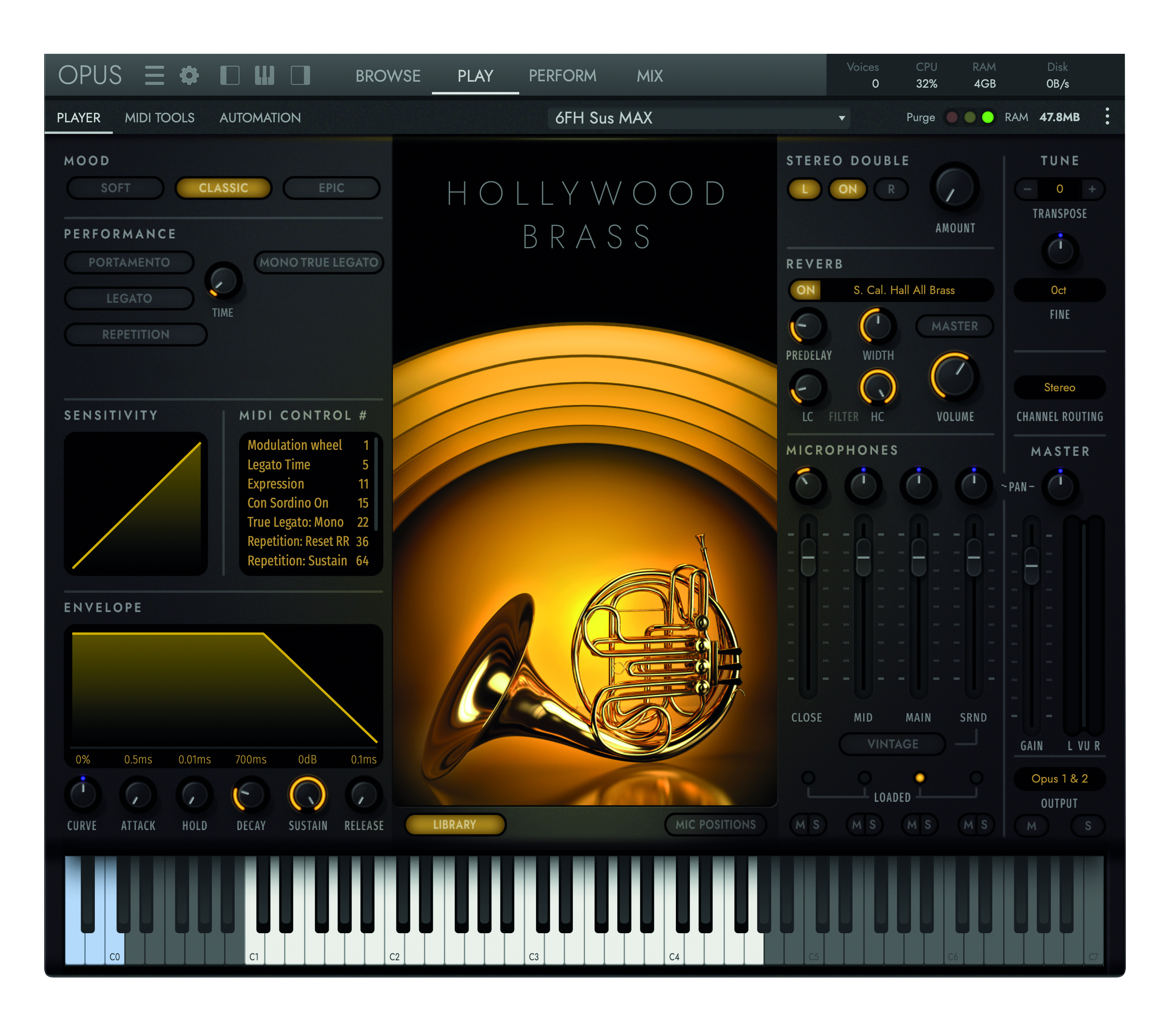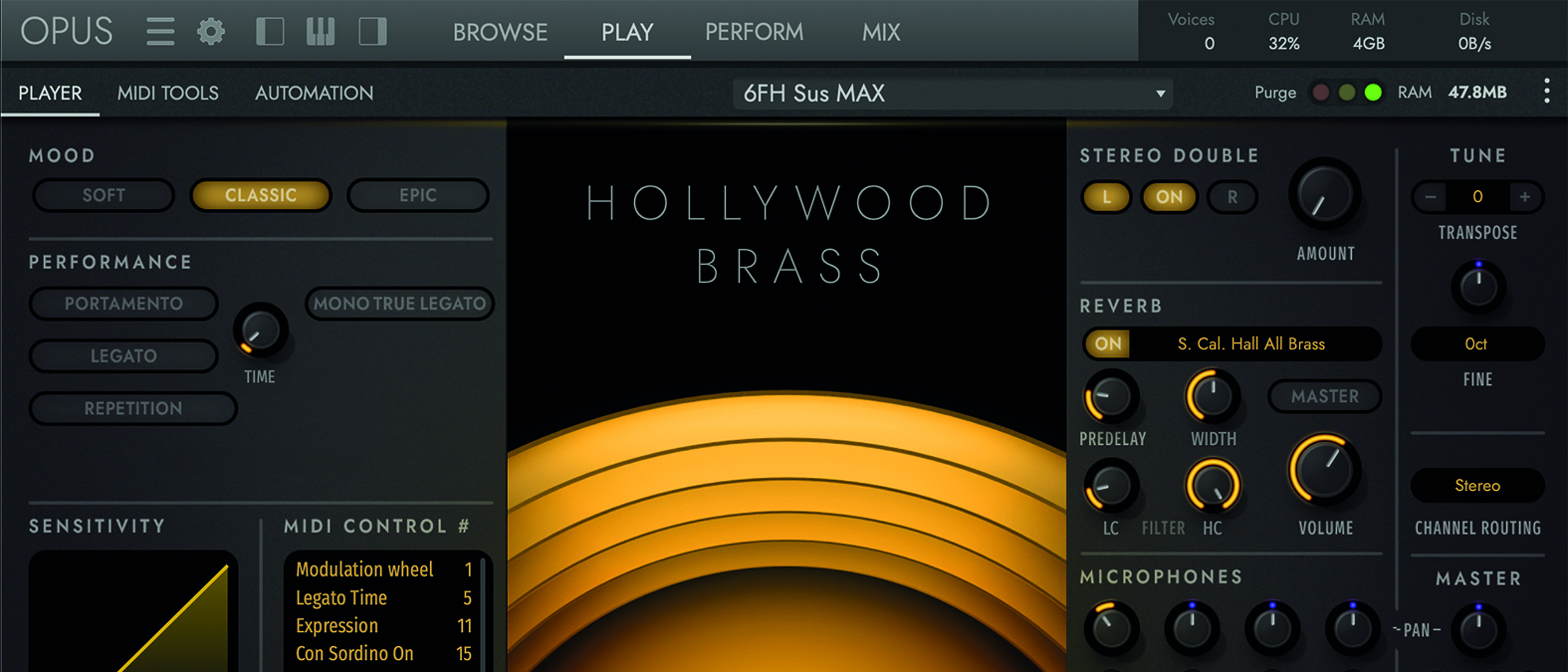MusicRadar Verdict
EastWest has set a new orchestral library standard with Hollywood Orchestra Opus, and The Orchestrator lifts the experience even further.
Pros
- +
Exceptionally advanced orchestral suite.
- +
Peerless instrument recordings.
- +
Hollywood Orchestrator provides unequalled creative control.
- +
Sublime new Opus engine, samples, effects and mixer section.
Cons
- -
Diamond version requires significant space.
MusicRadar's got your back
What is it?
Proudly affirming its exclusive access to their namesake studios – the legendary EastWest Studio One in Hollywood – EastWest excels at crafting immaculately recorded orchestral packages, with 2015’s Hollywood Orchestra series marking the pinnacle of their achievements.
Now the company revisits and re-adapts this six-year-old monolith, further perfecting its ambition to build the ultimate all-in-one software orchestra.
Magnum opus
First, let’s look at what the original Hollywood Orchestra offered, and what this more substantial package adds. Recorded by Hollywood sound engineer and industry stalwart Shawn Murphy, Hollywood Orchestra was a remarkably detailed assortment of sampled orchestral instruments, sporting a plethora of textures across the string, woodwind, brass and percussion spheres, all operable within EastWest’s (then) state of the art Play engine.
Deep control of these beautifully recorded instruments was wrangled by a wealth of playing styles, articulations and mic placements.
With this new Opus edition, those pretty peerless original recordings still provide the bedrock, but they’ve been re-situated within the slick new Opus engine. Designed by computer music genii Wolfgang Kundrus (he of Cubase, Nuendo and Studio One fame) as well as Wolfgang ‘Kontakt’ Schneider, Opus is a major improvement on the ageing Play engine.
There’s a whole heap of freshly recorded instruments and effects in the mix, too, across the string, brass and woodwind libraries. Of particular note is a robust 18 violin section within Hollywood Strings, which has an '80s childhood fantasy vibe; as well as the ability to define key switches to switch between every instrument articulation.
The redesign of the UI has significantly simplified the suite, with a strikingly pretty central visual providing easy-to-understand access to every parameter you need. Of particular note is the slick colour switch when adjusting between the new Mood choices per instrument (scalable between the intimate Soft, the mid-range Classic and the full-frontal Epic).
Want all the hottest music and gear news, reviews, deals, features and more, direct to your inbox? Sign up here.
Though these are the key advancements on paper, the package’s relationship with EastWest’s new ambidextrous Hollywood Orchestrator elevates the whole experience into something far richer.
Orchestrator is a new orchestral arrangement-shaping tool, and is the secret weapon to work up huge sounding scores at a super-fast rate, with real-time melodic line-adjustment presented in a DAW-like view.
Though its 500 mouth-watering presets are tantalisingly waiting to be fired up and explored, Orchestrator is no virtual cheat-sheet. The program encourages you to craft your own intricate movement within an orchestral patch. Professional software scorers facing tight deadlines will find it invaluable.

Performance and verdict
All the instruments that make up the numerous sub-suites of the collection were recorded at the EastWest Studio 1, and produced by Doug Rogers and Nick Phoenix, alongside the aforementioned Shawn Murphy, all of whom are luminaries in the professional scoring world.
The recordings therefore are at turns majestic, nuanced, bombastic and utterly soul-tickling. The major components comprise packages which span Brass, Orchestral Percussion, Orchestral Woodwinds, Solo Cello, Solo Violin, Harp and Strings, though they’re richly playable instruments in their own right.
The aim of Opus is to weave these instruments together, as crucial elements of the full orchestra.
Installation of the full product requires a significant investment of both cash and digital real estate, with the full Diamond version of the suite requiring nearly 1TB of free space – so make sure you’ve got significant hard drive capacity (though it’s possible to save library files to multiple drives).
Once installed, it’s easy to get started as either a standalone program, or as an AU, AAX or VST plugin within your DAW of choice. A useful series of windows asks questions which allow the software to fine-tune itself to your creative and technical requirements.

Getting to grips with the layout is rapid, as four main page selectors (Browse, Play, Perform and Mix) at the top of the UI provide quick access to the key tools. Browse allows you to select your packages, ensemble and individual sample sounds (which you can now audition before download).
Play is where you can get into the specifics of instrument control for a selected patch, with each currently active instrument appearing in the DAW-like instrument rack sidebar.
Perform opens up the ability to edit the key range, octave transposition and more, as well as providing quick access to Hollywood Orchestrator, while the brand new Mix page provides a series of channel strips, allowing inter-instrumental EQ and level controls, as well as the ability to add a slew of new insert effects. Within half an hour, we’re flipping between these pages with relative ease.
• Spitfire Audio BBC Symphony Orchestra Pro
Spitfire’s BBC package offers similar levels of dynamic control and excellent sample recording quality.
• Orchestral Tools Metropolis Ark 1
Recorded at Berlin’s Teldex Studio, OT’s first in the four-part Metropolis Ark series is a flagship suite of massive-sounding orchestral heft.
Once you’ve got to grips with instrument and patch loading, performing the full Opus orchestra via Hollywood Orchestrator is remarkable fun, with certain presets providing complex, epic-sounding scope with the hold of a simple chord.
Orchestrator’s Preset browser conveniently organises by Ensembles, Ostinatos, Scores and User.
Ensemble presets, in particular, are generally glorious showcases of just how astounding sounding these recordings are, and the degree of masterful control you can have over the huge sound, with wide sounding legato, sustains, crescendos and nuanced articulations being triggered by a single press, and each key activating different elements of the ensemble.
Full Ensemble Movie Apocalypse is a great example of the levels of bombast you can instantly summon up.
Ostinatos add pulses and tension to proceedings, while within Scores you can toy with all hues of blockbuster-level might.
The best method of performing these types of patches is to, with one hand, hold down the chord shape, while the other hand controls the volume via the mod wheel, this might seem alien to those used to delicately performing their samples in a pianistic way, but it’s the most logical way to control the countless mini-movements, and intensity, of an orchestra.
Though EastWest’s emphasis is on achieving cinema-grade orchestral power instantly, there’s simply mountains of creative scope within the Hollywood Orchestra Opus toolkit. It’s hard to envision how a package of this magnitude could be improved. Just make sure you’ve got the hard drive space!
MusicRadar verdict: EastWest has set a new orchestral library standard with Hollywood Orchestra Opus, and The Orchestrator lifts the experience even further.
The web says
"With Opus, EastWest brings a host of welcome improvements to its expansive orchestral library. Whether you're a long-time user or a first-time buyer, there is much here to get excited about."
MusicTech
Hands-on demos
EastWest
Specifications
- Minimum system requirements:
CPU: Quad-core (four cores), running at 2.7 GHz (or above)
RAM: 16 GB
OS: macOS 10.13 (or later); Windows 10 with ASIO sound drivers
Drive: SSD for HW Orchestra Opus Edition - Recommended system requiremnents:
CPU: Octa-core (eight cores), running at 2.7 GHz (or above)
RAM: 32 GB or more
OS: macOS 10.13 (or later); Windows 10 with ASIO sound drivers
Drive: NVMe SSD - Contact: Audiomodern
Computer Music magazine is the world’s best selling publication dedicated solely to making great music with your Mac or PC computer. Each issue it brings its lucky readers the best in cutting-edge tutorials, need-to-know, expert software reviews and even all the tools you actually need to make great music today, courtesy of our legendary CM Plugin Suite.

